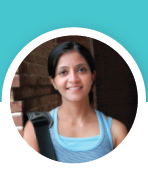Student Profile with Introduction

Keira Sharma, 18
Communications major
Sam Houston State University
 While my habits have worked well for me, students should get to know their own learning habits and find a reading method that works best for them.
While my habits have worked well for me, students should get to know their own learning habits and find a reading method that works best for them. 
Keira Sharma was born in Texas and then spent most of her childhood in Baton Rouge, Louisiana, where she learned study habits that have helped throughout her education. Just before high school, her family moved back to Texas. She decided to go to Sam Houston State University after visiting the campus and speaking with faculty and current students in the communications program. In addition, she thought that the campus was beautiful, and she liked the community. Last, it put her only an hour away from her family.
As someone who loves to learn, Keira came to college with some strategies in place. “There is definitely a lot more reading involved in college than in high school,” she says. “However, the good thing is that professors give out syllabi that detail when readings will be due, so you can plan accordingly.” Like many first-year students, she also had to learn to balance the amount of reading required. “I had to get used to measuring how long it took to read, and then manage my time accordingly.”
Many of the other strategies Keira employs revolve around good time management and organization. “Learning how to juggle all other coursework, meals, a social life, and sleep can be difficult, but it is possible. I mostly organize my time in order of priorities, usually based on due dates and how much time it takes to do [the assignment],” she says. Keira explains that once she starts reading, “I usually write down headings within the chapter as I go to keep me guided in the right direction and so that I know what the main point of upcoming sections will be. I then read through and write down any important dates, names, words, or anything that better explains the concept or explains it in a different way. This way I have multiple views on the subject that further enhance my understanding. It also doesn’t hurt to reread sections and go over notes.” She adds an important note: “While my habits have worked well for me, students should get to know their own learning habits and find a reading method that works best for them.”
Keira also has some simple advice for other first-year students: “As much work as college is and as overwhelming as it can feel sometimes, don’t stress too much. College is one of the best times of life. Enjoy it!”
As Keira mentions, reading college textbooks is more challenging than reading high school texts or reading for pleasure. College texts are loaded with concepts, terms, and complex information that you are expected to learn on your own in a short period of time. To accomplish it all, you will find it helpful to learn and use the active reading strategies in this chapter. They are intended to help you get the most out of your college reading. This chapter will also explore different strategies you can use when reading textbooks across the academic disciplines. These strategies include building your overall vocabulary and increasing your familiarity with terms that are unique to your particular field of study. Choose to make your textbook reading something you do every day. Reading in small chunks will help you concentrate and will increase your comprehension.
Depending on how much reading you did before coming to college—reading for pleasure, for your classes, or for work—you might find that reading is your favorite or least favorite way to learn. When you completed the VARK learning styles inventory in the chapter “How You Learn,” you determined your preferences about reading and writing as a learning strategy. Even if reading isn’t your favorite thing to do, it is absolutely essential to doing well in college and at work—no matter your major or profession.
|
assess your strengths Are you a good reader? Do you make it a practice to do all the assigned reading for each of your classes, and do you have strategies for highlighting, annotating, or taking notes on what you read? Do you understand what you read so that you can explain it to others? As you read this chapter, consider your strengths in reading college textbooks and other academic materials. |
set goals What are your most important objectives in learning the material in this chapter? How can you improve your reading abilities and strategies? Use this chapter to help you develop strategies and goals for improving your reading of college texts. Check your course syllabi regularly to make sure you’re up-to-date with all your assigned reading. Set a goal to catch up when you get a little behind. |